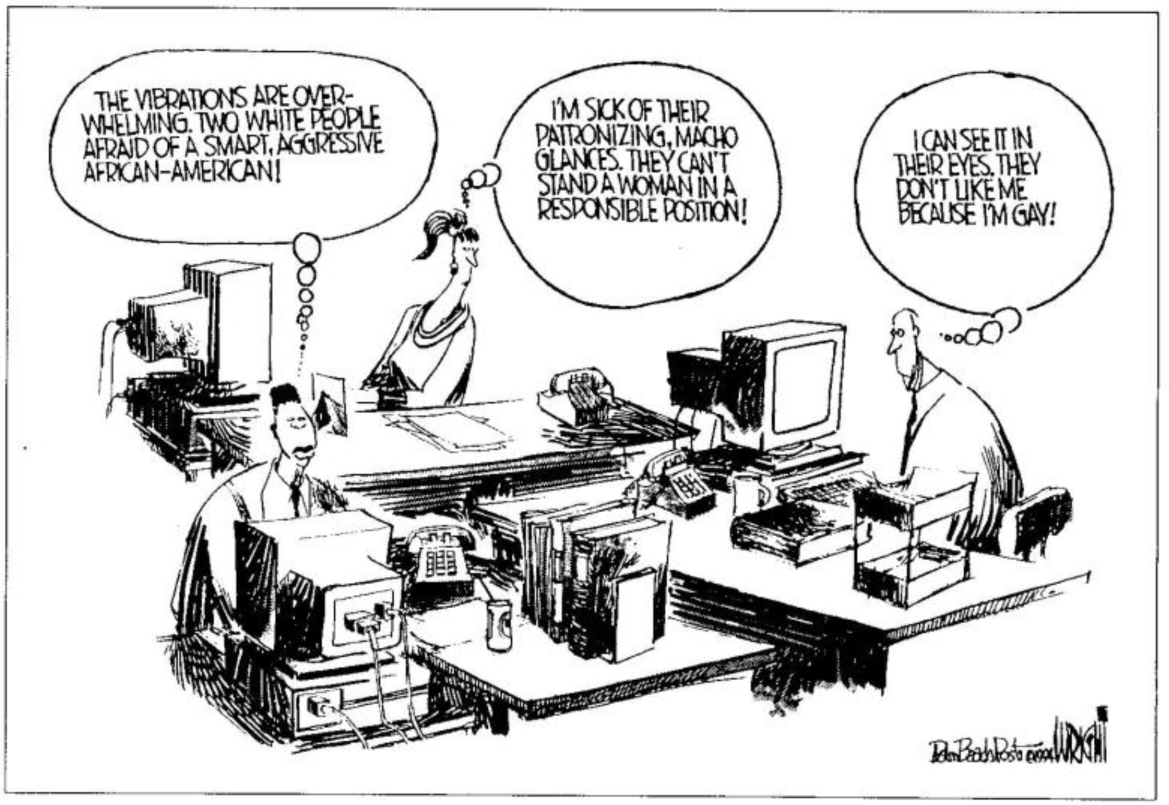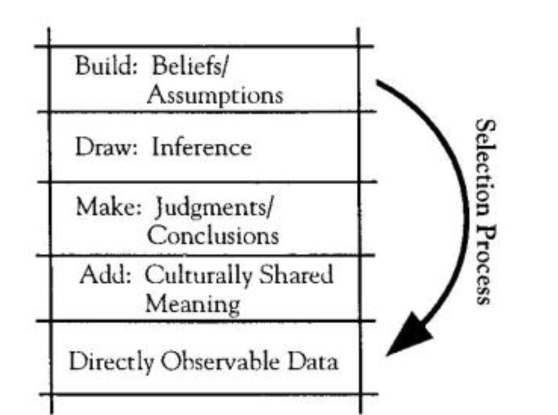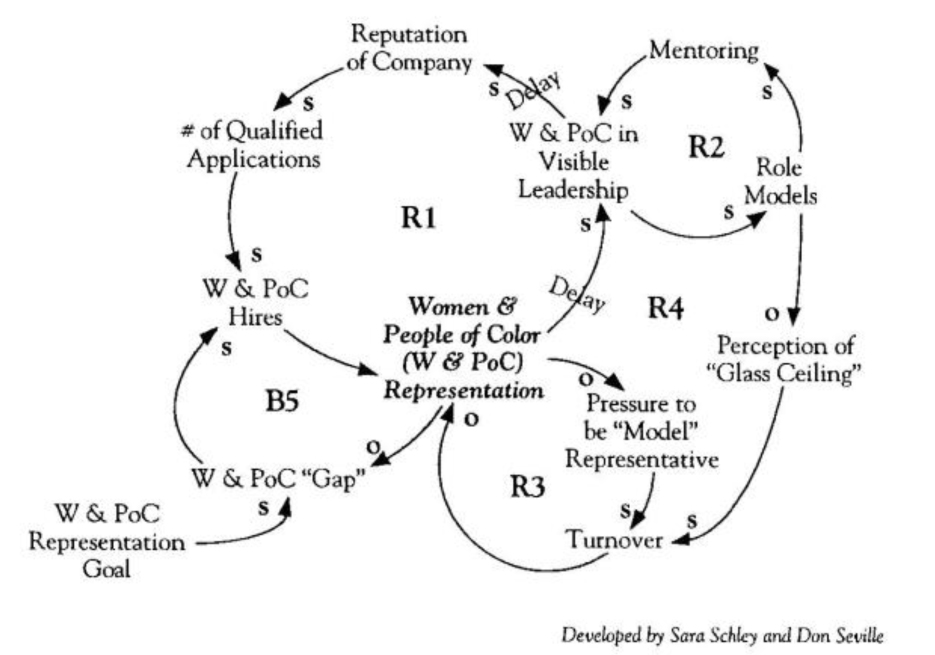Effectively managing and benefiting from diversity poses a significant challenge to our organizations. Regardless of a person’s race, gender, or sexual orientation, they do not leave their core identity at the door when they walk into work. Nor are their fears and prejudices left outside. Although we might wish for a work-place in which identity concerns are nonexistent, not discussing these issues does not mean that they will go away.
It is a simple fact of modern corporate life that our organizations are multicultural. According to the U.S. Bureau of Labor Statistics, women comprised 47% of the U.S. workforce in 1992, while blacks accounted for 11% and Hispanics 8%. For many structural and attitudinal reasons, however, most companies have not benefited from the competitive advantage these differences offer. Well-managed multicultural organizations can draw on a diversity of perspectives that engender collective thinking, an essential skill in complex business environments. While past discussions of the learning organization have focused extensively on the role of team learning, they have, nonetheless, largely ignored the impact of diversity on learning and team effectiveness.
Culture and Performance
Most managers are aware of the destructive potential that emerges when prejudice and narrow-mindedness lead to exclusion and missed opportunities. Differences between men and women or among people of different racial and cultural backgrounds may easily lead to miscommunication and misunderstandings, which intensify if left unaddressed. Over time, this creates a setting that destroys morale and eventually poisons the work atmosphere.

Managers may not be aware of the extent to which prejudice can become systemic and institutionalized. The inability to deal with differences constructively impedes learning among people, groups, and divisions, and can weaken an organization’s ability to cope with rapid changes. Effectively addressing diversity requires examining both personal and group interactions as well as the system as a whole.
We believe the organizations that will survive and thrive in the future will be those that can best harness the creative forces of multicultural perspectives. Race and gender differences offer an excellent learning opportunity for any firm interested in developing both its people and its markets. Diversity is not just a way of managing people, it is a way of doing business that recognizes that good strategy, market penetration, personnel retention, and the creation of a safe workplace are enhanced by exploring cultural differences.
Culture as Mental Models
Culture is the glue that binds us to others through shared language, goals, and lifestyles. Lionel Trilling, a cultural anthropologist, calls culture a set “of learned behavior patterns so deeply ingrained they produce unconscious, involuntary reactions.” Our culture affects what we pay attention to and what we ignore. All human interactions include this interpretive process.
Often we can’t “see” or describe our own culture, however, until we come into contact with someone from another culture. In such intercultural contact there is frequently a sense of threat — a feeling that one or another perspective must be “right.” Cross-cultural learning happens in that paradoxical moment when we accept the validity of each worldview: “both/and” rather than “either/or.”
The discipline of working with mental models can foster cross-cultural learning by helping to make our interpretive process explicit. The “Ladder of Inference,” described by Harvard professor Chris Argyris, provides a simplified model of how we think and process our experiences. According to Argyris, we interpret events very quickly and draw conclusions about those experiences based on highly selective data (see “Paradigm-Creating Loops: How Perceptions Shape Reality,” March 1993).
At the bottom of the “Ladder of Inference” is directly observable data. From the data pool of life, our culture tells us what to perceive. For example, an Eskimo can actually see and name 22 different kinds of snow, whereas someone from the tropics might think of snow only as a cold, white mass. Moving up the ladder, we add culturally shared meaning — interpreting and making sense of an event by the norms of our culture. We then make judgments and draw inferences based on those meanings. These judgments and inferences — which are culturally conditioned — influence our beliefs and assumptions, which then affect the way we view new observable data (see the “Practitioners’ Corner” for example of how this might play out in the work-place).
Drawing inferences is important because it helps us relate to each other — enabling us, for example, to quickly interpret facial expression, body posture, verbal comments, and tone of voice. However, it can also lead to prejudice as we interpret others’ behavior within our own cultural framework. These beliefs and assumptions then affect our views and attitudes toward people from other cultures. if left untested, these negative attributions can hinder the shared learning of people from different groups.
As Peter Senge says in The Fifth Discipline, “If we believe people are untrust-worthy, we act differently from the way we would if we believed they were trust-worthy.” The insidious component of this dynamic is that it is instantaneous and largely unconscious — we may not even realize that we are screening information or acting differently based on our beliefs and assumptions.
But when people of different cultural backgrounds meet with an attitude of inquiry, significant learning can result. Organizations can evolve powerful shared cultures of their own as members develop a common understanding of how to listen and speak to one another in ways that enable effective action. In order to learn from our differences, however, we need to create specific settings in which such “hot” topics can be constructively addressed.
Creating a Container for Constructive Conversation
Even the best managers often avoid the hard work necessary to build an effective multicultural organization because of the strong feelings associated with the topic. When we begin to address issues of race and gender, for example, there is tremendous emotional energy in the room. Often, there is fear of the destructive potential of this energy — the question is whether we will be able to use it constructively. A setting in which powerful emotional energy can be contained and transmuted can be thought of as a vessel or container. Creating a strong container, where a group can work through difficult issues, requires two types of commitment: an agreement among the individuals about how they will act, and commitment at the organizational level to establish a supportive organizational context for the work (see “Personal and Organizational Commitment”).
Once we have established a safe space, threatening topics (called “undiscussables” by Chris Argyris) can be raised. For example, at a manufacturing plant in Texas, the plant manager (a Caucasian male) was confronted by reports of racial slurs on the shop floor. In addition, many women in the plant were disturbed by the lack of advancement among talented female supervisors. George knew that he needed to work with the women and people of color in his plant in order to address these situations.
After a preliminary assessment of the overall plant environment, he invited a cross-section of leaders and high performers to a session facilitated by people from outside the plant. The purpose of this gathering was threefold: to review the current state of the plant; to learn an approach to skillful discussion; and to gain education on multicultural issues. The group weathered some very heated discussions. George took responsibility for his role in letting the situation deteriorate. Other members of the group acknowledged that they also did not take action, even though they knew it was needed. It became clear that George had felt powerless to raise and discuss the issues that concerned him, and those around him had felt powerless as well.
From this session, a greater sense of commitment and partnership developed, and the group emerged with a plan that included educating managers and supervisors, developing a business case for cultural diversity, establishing networks for women and people of color, coaching the top management team, and reassessing the hiring and promotion policies. It was also clear that this type of deep conversation needed to continue. A representative group of 18 people continued to meet monthly for both conversation and action on diversity and performance issues in the plant.
Structural Forces Learning to surface and discuss the role that culture plays will only take us so far in creating a high-performing multicultural workplace. In addition to being able to communicate and work across cultural lines, we also need to in-corporate a multicultural perspective into business strategy and structure. While demographics tell us that our organizations as a whole are diverse, they are not multicultural with respect to authority, power, and influence. The majority of women and people of color are working at middle and lower levels of the organization. In 1990, only 19 of the top 4012 highest paid executives in the U.S. were women. In 1987, only 4.9% of senior managers were black. What untapped business strategies and markets could open up if companies capitalized on the multicultural perspectives at all levels of their workforce?
Personal and Organizational Commitment
- Personal experiences will be kept confidential.
- Conflicts will be seen through to completion, to arrive at a sense of shared learning. No one will leave in the middle of a conflict.
- Sessions are a priority, and everyone must be fully present.
- There is a “no blame” stance—everyone is a partner in learning, not fault finding.
- Individuals must examine their own roles and responsibilities in the current reality.
- All participants commit to listening fully to each other.
Organizational Level:
- Organizational leadership shows interest in and willingness to address cultural diversity issues.
- Organizational leadership creates a clear business case for cultural diversity.
- There is a shared understanding that valuing diversity reinforces organizational learning and organizational learning reinforces the valuing of diversity.
- There is a shared understanding that working on diversity issues helps the organization become more effective.
Practitioners' Corner
Sam comes to you for a job interview. His resume and references are impressive. On paper he has all of the qualifications for the job. You are looking forward to meeting him, knowing that you are in a crunch to find somebody with his skills. The interview, however, is disappointing. Every time you ask Sam a challenging question, he looks away or down at his lap. You cannot establish eye contact with him and thus cannot connect with him on a personal level. Unable to establish this level of trust with Sam, you begin to doubt his ethical standards. Despite his impressive qualifications on paper, you simply don’t have a good feeling about him. Trusting your instincts and experience with the company, you decide that Sam will not be a good “fit” for your group and decide not offer him the job. What happened? If we analyze the interview using the “Ladder of Inference,” we can trace through the thought pattern: 1) You made the observation that Sam did not look you in the eye. 2) To this, you added the cultural meaning that he may not be trustworthy. 3) You made the assessment that he will not fit into your group, and 4) came to the conclusion not to offer him the job. The information that you did not have is that, because Sam is Cambodian, he was taught that it is disrespectful to look an authority figure directly in the eye. Therefore, his avoidance of eye contact was a way of showing you respect. Unfortunately, your multicultural illiteracy lost you a talented new hire.

Developing an organization that is truly multicultural with respect to authority, power, and influence requires a system wide approach. There are many independent variables related to achieving this outcome: recruiting, hiring, promotions, incentives, rewards, accountability, review processes, mentoring, role models, support networks, training and education, etc. Companies who address one of these issues in isolation often meet with failure in their attempts to create diversity at all levels of the organization. For example, in an attempt to balance representation in the company, they may increase the recruitment of people of color and women, but fail to address mentoring, role models, or support groups. Without these structural forces in place, turnover may remain high and the company’s espoused objective of increasing multicultural diversity at senior levels will go unmet.
The Dynamics of Diversity
 W 8 PoC Women and People of Color
W 8 PoC Women and People of Color
To be most effective, diversity interventions should focus on more than one reinforcing dynamic at the same time. For example, increasing the number of women and people of color in the company will help bring snore qualified applicants (RI), while role models and mentoring programs can help ensure that those skilled employees stay with the company (R2 and R4) ./caption]
A causal loop diagram can help articulate some of the interdependencies between variables. Let’s say, for example, that you have decided to set a goal of increasing representation of women and people of color at upper levels of the organization to reflect the market and labor demographics of the surrounding community. You recognize that there is a gap between the current and desired numbers. If the company begins to hire more women and people of color at these levels, their representation in the company goes up, which eventually leads to more women and people of color in visible leadership positions. As this happens, the reputation of the company among applicants improves, and more qualified women and people of color apply, leading to even greater representation within the company (RI in “The Dynamics of Diversity”).
Another reinforcing action you could take is to create mentoring programs. With more people of color and women in leadership positions, the number of role models and mentors increases (R2). The perception of a “glass ceiling” decreases, which may lead to a decrease in turnover. This decreased turnover positively influences representation in the company — with more women and people of color, the pressure on individuals to be “model representatives” of their group decreases (R3).
Of course, the same reinforcing loop dynamics that lead to a virtuous cycle of increased representation (R1) can also lead to a vicious cycle. For example, if the number of women and people of color decreases, the pressure on each remaining individual to be a “model representative” increases, which leads to increased stress among the employees and an increase in turnover. A similar dynamic happens if the number of role models decreases.
Multi-cultural Dialogue
To truly create the type of organizations that are necessary in today’s diverse cultures, leaders with both organizational learning and diversity mandates may find it most effective to combine those efforts for a synergistic effect. Organizational learning interventions can benefit from a multicultural perspective that welcomes cultural differences as an opportunity for creative exchange and generative thinking. Similarly, diversity efforts are well served by the approaches of openness, inquiry, shared vision, and systems thinking that the disciplines of organizational learning suggest.
As organizations develop their capacity to value diversity, they enhance their capacity to learn. This ability to learn enables them to be open to diverse ideas, strategies, and markets — resulting in increased performance. Though difficult to implement operationally, the functional multicultural learning organization offers opportunities for personal and financial growth that we believe are well worth the investment.
Authors’ Note: In sharing our thoughts with you, we seek to open up a dialogue in the community of systems thinking practitioners to explore the relationship between multiculturalism, learning, and effectiveness in organizations. The issues are challenging and complex; no one individual or group holds the “answer.” We invite you to join to in this exploration.
Marilyn Paul, Ph.D., (Cambridge, MA) has been consulting to organizations for 12 years. She is a principal consultant with the Kaleel Jamison Consulting Groups, specialists in creating High Performing Inclusite Organizations.
Sara Schley, MBA, (Wendell, MA) is a consultant working with the Organizational Learning Center at MIT. She has a passion for work in diversity and in organizational change and seeks to build a bridge between those two fields in practice. Editorial support provided by Colleen Lannon-Kim.
